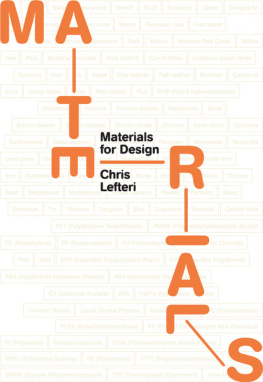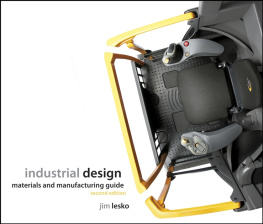Chris Lefteri - Materials for Design
Here you can read online Chris Lefteri - Materials for Design full text of the book (entire story) in english for free. Download pdf and epub, get meaning, cover and reviews about this ebook. year: 2014, publisher: Laurence King Publishing, genre: Home and family. Description of the work, (preface) as well as reviews are available. Best literature library LitArk.com created for fans of good reading and offers a wide selection of genres:
Romance novel
Science fiction
Adventure
Detective
Science
History
Home and family
Prose
Art
Politics
Computer
Non-fiction
Religion
Business
Children
Humor
Choose a favorite category and find really read worthwhile books. Enjoy immersion in the world of imagination, feel the emotions of the characters or learn something new for yourself, make an fascinating discovery.
- Book:Materials for Design
- Author:
- Publisher:Laurence King Publishing
- Genre:
- Year:2014
- Rating:3 / 5
- Favourites:Add to favourites
- Your mark:
- 60
- 1
- 2
- 3
- 4
- 5
Materials for Design: summary, description and annotation
We offer to read an annotation, description, summary or preface (depends on what the author of the book "Materials for Design" wrote himself). If you haven't found the necessary information about the book — write in the comments, we will try to find it.
Materials for Design — read online for free the complete book (whole text) full work
Below is the text of the book, divided by pages. System saving the place of the last page read, allows you to conveniently read the book "Materials for Design" online for free, without having to search again every time where you left off. Put a bookmark, and you can go to the page where you finished reading at any time.
Font size:
Interval:
Bookmark:
Materials for Design
Dedication: For my mum and dad, Androulla and Stasi. I owe it all to you.

Published in 2014
by Laurence King Publishing Ltd
361373 City Road
London ec1v 1lr
Tel +44 20 7841 6900
Fax +44 20 7841 6910
E
www.laurenceking.com
Design copyright 2013 Laurence King Publishing Limited
Text copyright 2013 Chris Lefteri
Chris Lefteri has asserted his right under the Copyright, Designs and Patent Act 1988 to be identified as the Author of this work.
All rights reserved. No part of this publication may be reproduced or transmitted in any form or by any means, electronic or mechanical, including photocopy, recording or any information storage and retrieval system, without prior permission in writing from the publisher.
A catalogue record for this book is available from the British Library
ISBN 978 178067 344 8
Designed by Studio Aparte
Project Editor: Gaynor Sermon
Copy Editor: Lindsay Kaubi
Printed in China
Materials for Design
Chris Lefteri
Laurence King Publishing
CONTENTS
INTRODUCTION
This book is for anyone interested in or involved in designing with physical materials. It is not a scientific or historical analysis of materials, but instead serves as an aid to understanding the current state of materials which are the most commonly used and which are potentially the materials of the future. It embraces all areas of design and production, from products made as one offs to those mass-produced in the scale of millions of units per year, from highly desirable design pieces to some of the everyday objects that we take for granted. I first started writing about materials in 1999 and I stated then that we were only at the beginning of our exploration into this area: fourteen years later this still remains true, and a significant development is that material innovations are not just coming from the science community but increasingly from designers themselves. This book is a celebration of the range of established materials that designers are innovating with and materials that they are creating from scratch.
Like trying to capture a family photograph when all the family members are moving, is how Ezio Manzini described materials in 1989 in his book The Material of Invention. As time accelerates the introduction of new types of materials, so the classification of materials families continually needs to be redefined. The established descriptions that have been used to define materials families such as plastics, metals and woods seem to become less and less relevant. With the blurring of the boundaries between these materials families, its getting harder to work with the old definitions. For example, plastics are more and more often encroaching on the territories of other materials, such as innovations in bioplastics made from cellulose fibres or plastics that are taking the place of metals for lightweight, corrosion-resistant applications.
Alongside the evolution of new technologies and grades of materials, something else is happening that is changing the value they have in our lives. This is not linked to the science of new materials but concerns the role they play in contemporary life. Materials are increasingly becoming central characters in consumer focused stories: antibacterial surfaces to improve hygiene; advanced composites that define luxury in consumer electronics; authentic real materials in interiors like stone, glass and stainless steel; the use of eco materials to alleviate our guilt and make us feel like more caring consumers.
These material stories not only help brands differentiate themselves from each other, but facilitate designs that drive a desire in consumers to buy into these stories. However, beyond this desire, there is also a genuine initiative to find alternative, sustainable sources of materials. This area is being driven as much by science as it is by ever-curious designers like Suzanne Lee, with her marvellous innovation of a material grown from bacterial cellulose (see page 60), who are increasingly developing the actual materials themselves rather than merely just applying materials in designs as an afterthought.
So, as innovations in materials continues to take place unabated, why is this a good moment to take a breath and consider the role of materials and how they might be applied in design? Partly because looking at design through the lens of materials is always an interesting place to see updates and new innovations, but also because the world and the connection we have with materials is going through an incredible change, driven by the two main themes of desire for materials stories and a need to find sustainable solutions. As a result, the use of materials is becoming much more important for designers, not just through developing new materials but also by having a better understanding of their properties and values. This book takes a snapshot of over one hundred raw materials and presents key information that that designers should know about when considering materials for design.
Unlike the materials revolution of the last hundred years, the next materials age wont be as visible. It wont lead to the kind of visions of the future that we had in the 1950s, with a Jetsons-style future of pastel-coloured, aerodynamic vehicles flying about our heads. The themes will be many, but for sure they will be driven by low-energy production and applications, materials scarcity and new interactions with materials. Some materials innovations are, unlike plastics, metals or ceramics, invisible: for example, the information that you receive on your phone, laptop, TV, or the increasing number of other screen-based electronic devices will change the physical interaction you have with materials rather than change the way they look; our need to explore new sources of energy might mean that the road you drive down wont just be a path for cars, but a surface to generate electricity; the walls of a room wont simply be a place to decorate with your favourite colour but where you choose the functions that best suit your home noise reduction, smell neutralisation, pollution killing. This book would be doubled in size if it were to include all of these types of materials technologies, and perhaps they will form a second instalment.
The three sections in this book are not based on the traditional definitions of materials but instead are categorized through the provenance of these materials. As our focus on the need to reduce resources continues, then where materials originate whether grown, mined or oil based becomes more important. The selection of materials within each of these sections is not exhaustive but instead attempts to capture those materials that are the most useable, used, important or just downright inspiring for designers. For some materials the case-studies that accompany them are from specific designers, such as the lightweight aluminium 2012 Olympic torch by Barber Osgerby (see page 174), and in some cases they are from everyday products that are typified by their use of the particular material, such as the crafting of willow for cricket bats (see page 42). The selection is based on raw materials steel, oak, polystyrene, soda-lime glass for example and not semi-formed materials that have been transformed into sheets (such as well known brands like Corian or Lycra). The information given for all the materials is kept consistent, allowing for crossreferencing across the properties of different types of materials. Where costs have been included, it should be noted that prices fluctuate and those given are estimates that should be used for comparative purposes only.
I hope that this book will make you ever more curious about the materials of today, tomorrow and the not-so-distant future. Please dig in and enjoy!
Next pageFont size:
Interval:
Bookmark:
Similar books «Materials for Design»
Look at similar books to Materials for Design. We have selected literature similar in name and meaning in the hope of providing readers with more options to find new, interesting, not yet read works.
Discussion, reviews of the book Materials for Design and just readers' own opinions. Leave your comments, write what you think about the work, its meaning or the main characters. Specify what exactly you liked and what you didn't like, and why you think so.





![Chris Crawford [Chris Crawford] - Chris Crawford on Game Design](/uploads/posts/book/119438/thumbs/chris-crawford-chris-crawford-chris-crawford-on.jpg)
![Chris Bateman [Chris Bateman] - Beyond Game Design: Nine Steps Toward Creating Better Videogames](/uploads/posts/book/119409/thumbs/chris-bateman-chris-bateman-beyond-game-design.jpg)
